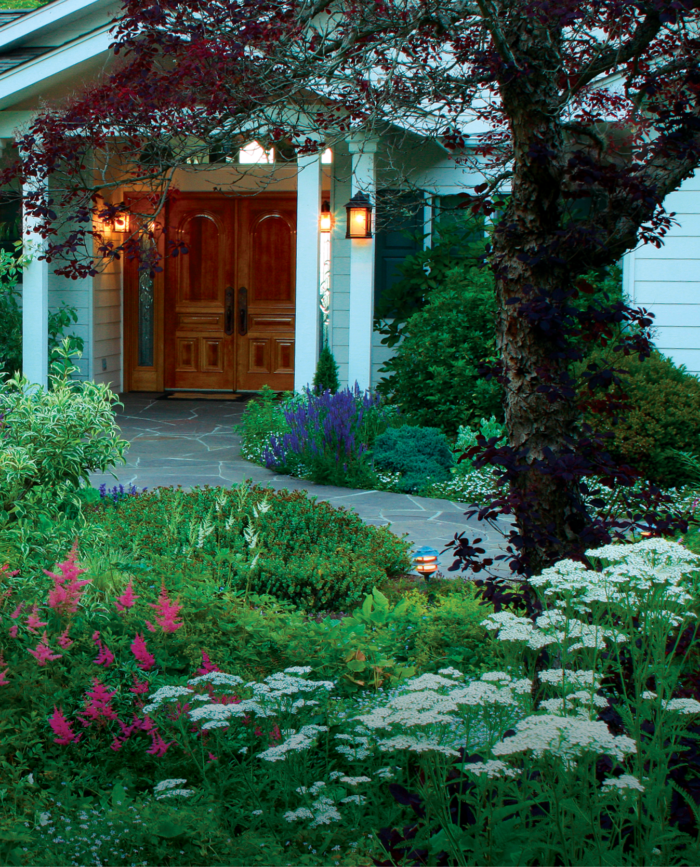
Create a garden that looks good all of the time. An exciting entry should be more than just a collection of seasonal stars; it must also have plants that establish a strong framework.
The entrance of a home deserves special attention because it is the first impression that guests have when arriving and the last impression they have as they leave. As a garden designer, I always try to remember that fact before starting a project.
But when it came to designing the front garden for Colette’s Bed and Breakfast in Port Angeles, Washington, the stakes were even higher. This space had to be beautiful all the time because of the continual flow of guests. But it had to be more than just beautiful; it had to be engaging because it represented a business dedicated to making people feel at ease. My plan for the space involved establishing a winter framework, choosing a series of focal plants, and building layers around those stars. Paying attention to how every plant would grow and change through the seasons was also essential to the success of the design. The end result is a garden that is not only eye-catching but also welcoming during every day of every season.

Spring: Kick things off with ephemerals
Ephemerals are a crucial piece in a four-season entry garden because they shine when much of the garden is sleeping but then obligingly go dormant to leave room for late-spring stars, like geraniums and poppies. Although their transitory and fleeting nature can leave behind small holes in the garden, the blank spots are not large enough to be considered eyesores. Some ephemerals will persevere without minding if they are shaded by the emerging foliage of later-blooming companions. This means the same space can offer two or three seasons of interest. After these early gems fade, I make sure the garden has a few plants that will put on an exuberant show, like ‘Victoria’ California lilac and white rock rose.
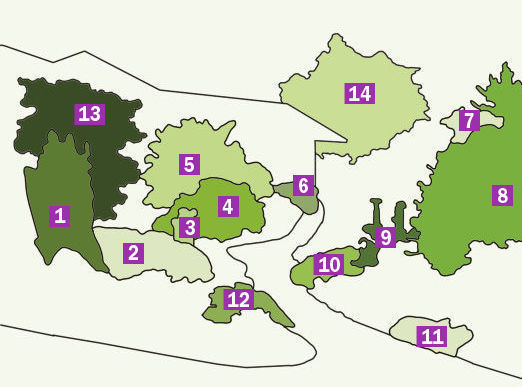
1. Giant feather grass (Stipa gigantea, USDA Hardiness Zones 8–11)
2. Bigroot geranium (Geranium macrorrhizum, Zones 4–8)
3. Ornamental onion (Allium aflatunense, Zones 4–8)
4. White rock rose (Cistus × corbariensis, Zones 8–10)
5. ‘Victoria’ California lilac (Ceanothus ‘Victoria’, Zones 7–9)
6. Showy geranium (Geranium × magnificum, Zones 4–8)
7. Rosebay rhododendron (Rhododendron maximum cv., Zones 4–9)
8. Weeping willow-leafed pear (Pyrus salicifolia ‘Pendula’, Zones 5–9)
9. ‘Patty’s Plum’ poppy (Papaver orientale ‘Patty’s Plum’, Zones 3–9)
10. Grey-leafed hebe (Hebe glaucophylla, Zones 9–10)
11. Variegated rock cress (Arabis procurrens ‘Variegata’, Zones 3–7)
12. Spring heath (Erica carnea cv., Zones 5–7)
13. ‘Forest Pansy’ redbud (Cercis canadensis ‘Forest Pansy’, Zones 4–9)
14. Purple leaf plum (Prunus cerasifera* ‘Atropurpurea’, Zones 5–9)
*See invasive alert below.

Summer: Focus on form and longevity
Each garden area should have a focal point that shines especially bright during the height of the season. This focal point can be a water feature, a sculpture, or a special plant. For this front entry, I chose to use primarily plants. The criterion for what qualifies a plant to be a focal point is pretty simple: It must be an attention grabber. Add a cast of complementary players and your garden will always have that wow factor that lifts it above the ordinary. I used, for example, giant feather grass, an evergreen with a 6-foot-wide cloud of golden seed heads in late summer, as a vertical centerpiece. But not all focal plants need to be imposingly big. Another trait that can designate a focal plant is a long-lasting presence. Plants with interesting foliage, like blazing star, keep the garden looking fresh and full because they generally don’t need to be cut back to the ground in midseason.

1. Pom-pom dahlia (Dahlia cv., Zones 9–11)
2. ‘Black Prince’ snapdragon (Antirrhinum majus ‘Black Prince’, annual)
3. ‘Elsie Heugh’ prairie mallow (Sidalcea malviflora ‘Elsie Heugh’, Zones 5–7)
4. Blazing star (Liatris spicata, Zones 4–9)
5. Cardoon (Cynara cardunculus*, Zones 7–10)
6. ‘Crimson Pygmy’ Japanese barberry (Berberis thunbergii* ‘Crimson Pygmy’, Zones 5–8)
7. ‘Bees’ Lemon’ torch lily (Kniphofia ‘Bees’ Lemon’, Zones 6–9)
8. Variegated moor grass (Molinia caerulea ‘Variegata’, Zones 5–9)
9. Red New Zealand hook sedge (Uncinia rubra, Zones 8–11)
10. ‘Autumn Joy’ sedum (Sedum ‘Autumn Joy’, Zones 3–9)
11. Tall verbena (Verbena bonariensis*, Zones 7–11)
12. Shasta daisy (Leucanthemum × superbum cv., Zones 5–8)
13. Giant feather grass (Stipa gigantea, Zones 8–11)
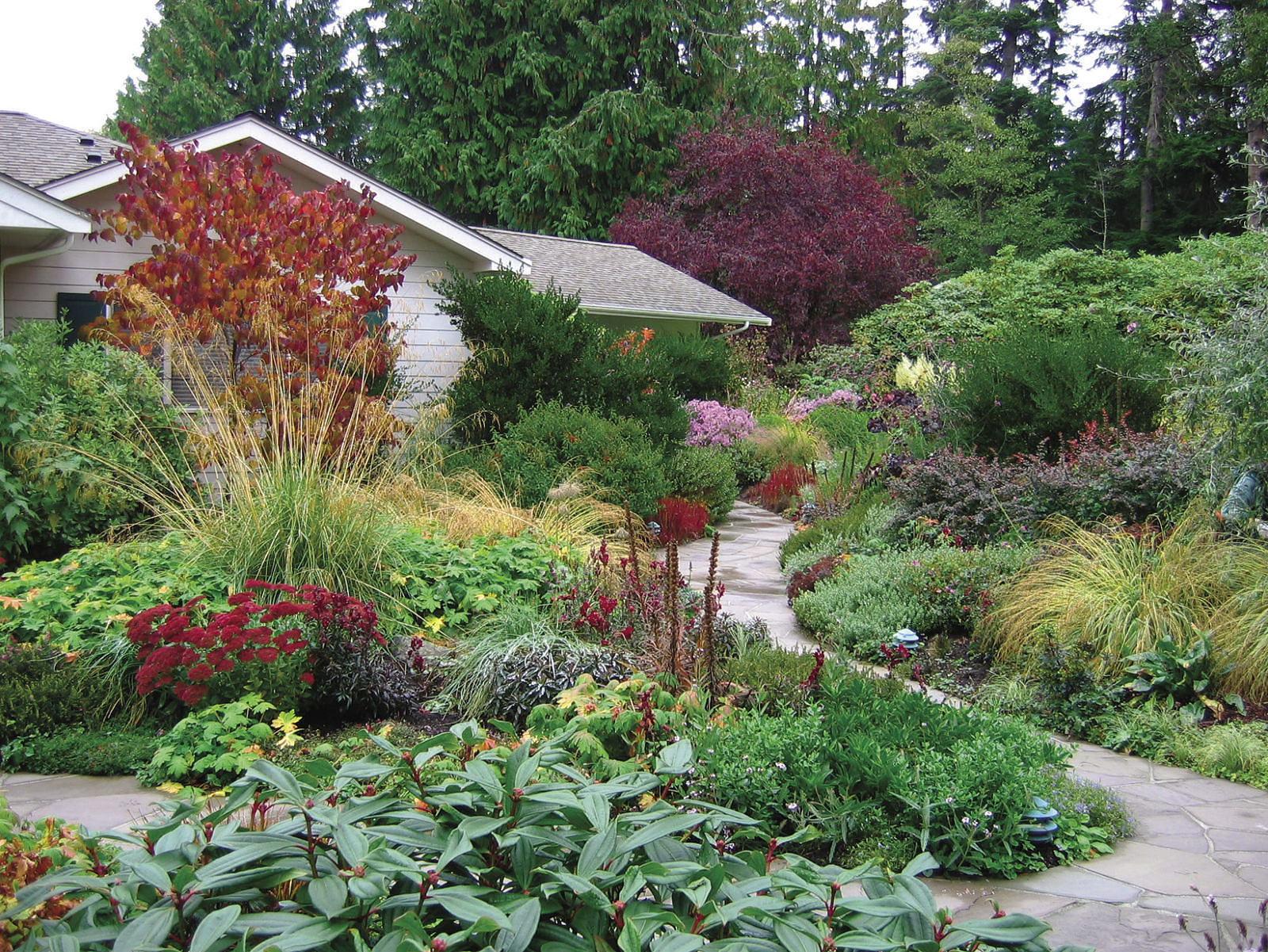
Autumn: Layers keep the show going
It can be a challenge for a garden to look full throughout the year, particularly in fall when plants begin to fade and go dormant. I like to build layers around my summer focal plants so that, when those stars begin to fade, second-string players are waiting to steal the attention. I select my filler plants by using contrast—playing off the color, the leaf size or texture, or the shape of my focal plant—but I always keep seasonality in mind. Trees provide the uppermost layer. If they have a high canopy and an unremarkable trunk, I snuggle a medium-size or tall shrub underneath. I use low-growing perennials at the feet of trees that have colorful bark or shapely trunks. I also plant small spring or fall bulbs around ground covers to take the layering one step further. Doing this gives the garden a lot of interest in a relatively small space and a feeling of fullness throughout the year.
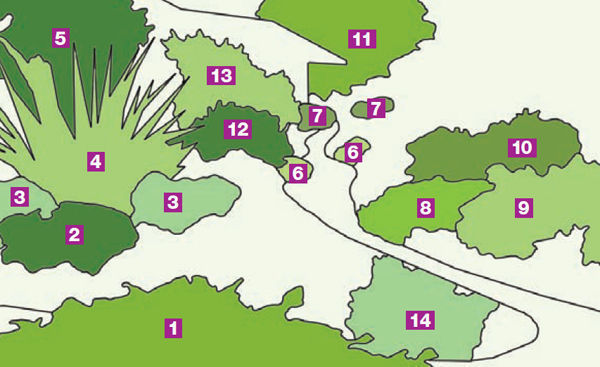
1. David viburnum (Viburnum davidii, Zones 7–9)
2. ‘Autumn Joy’ sedum (Sedum ‘Autumn Joy’, Zones 3–9)
3. Bigroot geranium (Geranium macrorrhizum, Zones 4–8)
4. Giant feather grass (Stipa gigantea, Zones 8–11)
5. ‘Forest Pansy’ redbud (Cercis canadensis ‘Forest Pansy’, Zones 4–9)
6. Japanese blood grass (Imperata cylindrica* ‘Rubra’, Zones 5–9)
7. Aromatic aster (Symphyotrichum oblongifolium, Zones 3–9)
8. Grey-leafed hebe (Hebe glaucophylla, Zones 9–10)
9. Variegated moor grass (Molinia caerulea ‘Variegata’, Zones 5–9)
10. ‘Crimson Pygmy’ Japanese barberry (Berberis thunbergii* ‘Crimson Pygmy’, Zones 5–8)
11. Purple leaf plum (Prunus cerasifera* ‘Atropurpurea’, Zones 5–9)
12. White rock rose (Cistus × corbariensis, Zones 8–10)
13. ‘Victoria’ California lilac (Ceanothus ‘Victoria’, Zones 7–9)
14. Rock penstemon (Penstemon baccharifolius, Zones 8–10)
*See invasive alert below.
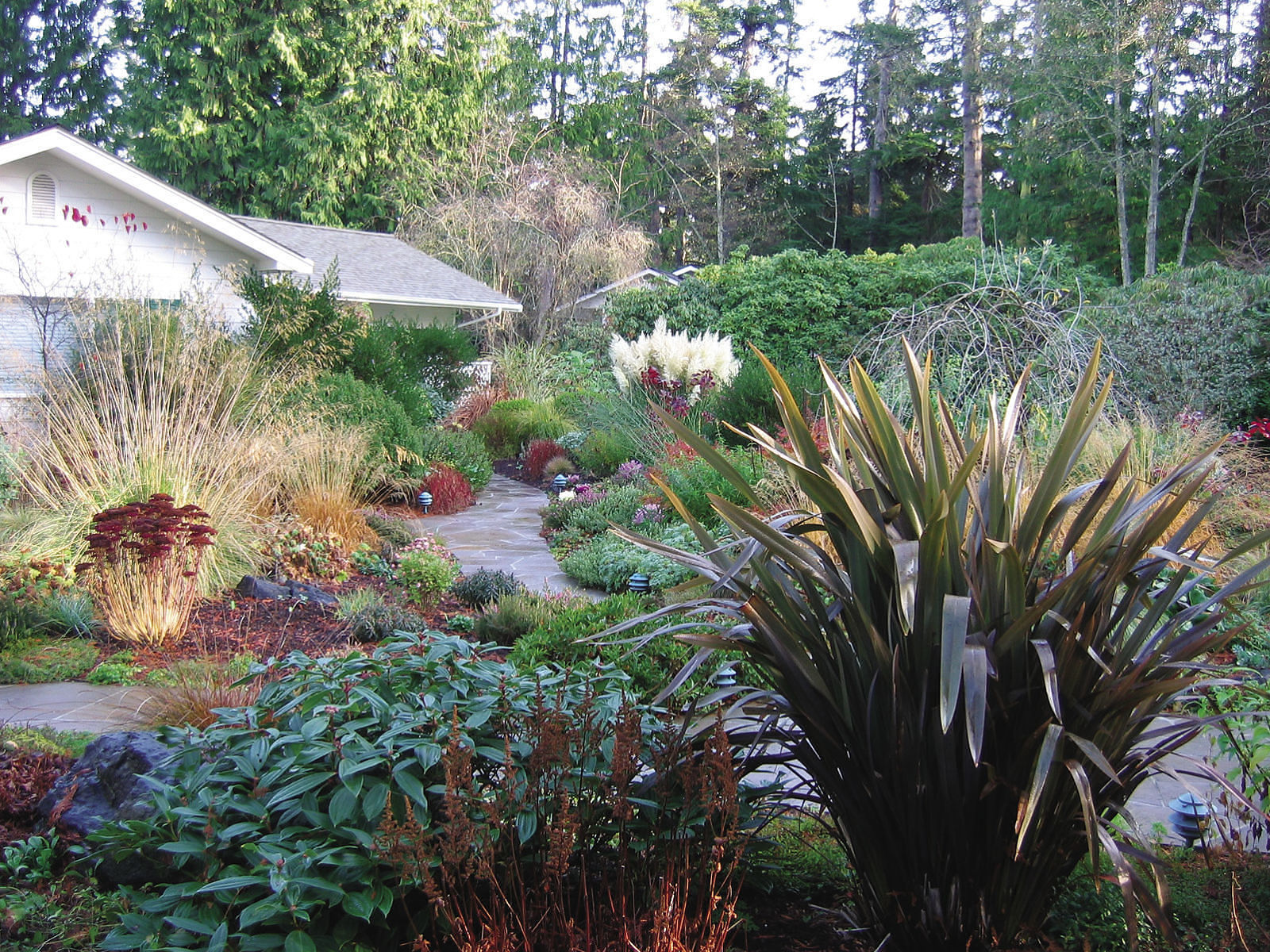
Winter: Provide a strong framework
For a garden to shine during the bleakest days of the year it needs an evergreen structure. It’s a lot easier to establish these bones of the garden at the start, instead of trying to incorporate them after. I like to place evergreens with heavy, solid shapes, like David viburnum, at the end of a border to signal a full stop and also in areas that mark a transition to a new part of the garden. Deciduous trees and shrubs can also provide a bold winter presence. Their lighter texture and coloring is a striking contrast to the denseness of the evergreens.
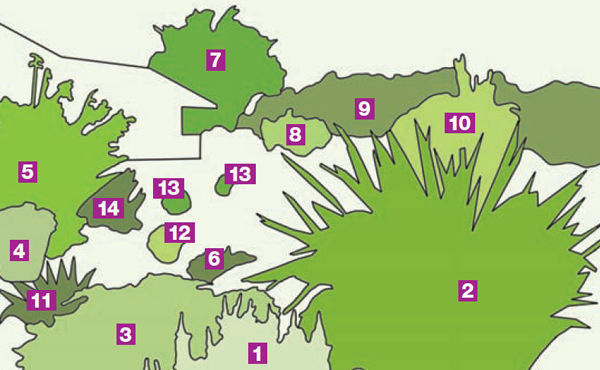
1. ‘Visions’ astilbe (Astilbe chinensis ‘Visions’, Zones 4–8)
2. Red New Zealand flax (Phormium tenax ‘Rubrum’, Zones 8–11)
3. David viburnum (Viburnum davidii, Zones 7–9)
4. ‘Autumn Joy’ sedum (Sedum ‘Autumn Joy’, Zones 3–9)
5. Giant feather grass (Stipa gigantea, Zones 8–11)
6. Rock penstemon (Penstemon baccharifolius, Zones 8–10)
7. Purple leaf plum (Prunus cerasifera* ‘Atropurpurea’, Zones 5–9)
8. Dwarf pampas grass (Cortaderia selloana* ‘Pumila’, Zones 7–11)
9. Rosebay rhododendron (Rhododendron maximum cv., Zones 4–9)
10. Weeping willow-leafed pear (Pyrus salicifolia ‘Pendula’, Zones 5–9)
11. Red New Zealand hook sedge (Uncinia rubra, Zones 8–11)
12. Spring heath (Erica carnea cv., Zones 5–7)
13. Japanese blood grass (Imperata cylindrica* ‘Rubra’, Zones 5–9)
14. Variegated moor grass (Molinia caerulea ‘Variegata’, Zones 5–9)
*Invasive alert: Cherry plum (Prunus cerasifera)
This plant is considered invasive in CA.
Invasive alert: Cardoon (Cynara cardunculus)
This plant is considered invasive in CA.
Invasive alert: Japanese barberry (Berberis thunbergii)
This plant is considered invasive in CT, DE, IA, IL, IN, KS, KY, MA, ME, MD, MI, MN, NH, NJ, NY, OH, PA, RI, TN, VA, VT, WI, and WV.
Invasive alert: Japanese blood grass (Imperata cylindrica)
This plant is considered invasive in AL, CO, FL, GA, MD, NC, and TN.
Invasive alert: Pampas grass (Cortaderia selloana)
This plant is considered invasive in AL and CA.
Please visit invasiveplantatlas.org for more information.















Comments
Log in or create an account to post a comment.
Sign up Log in